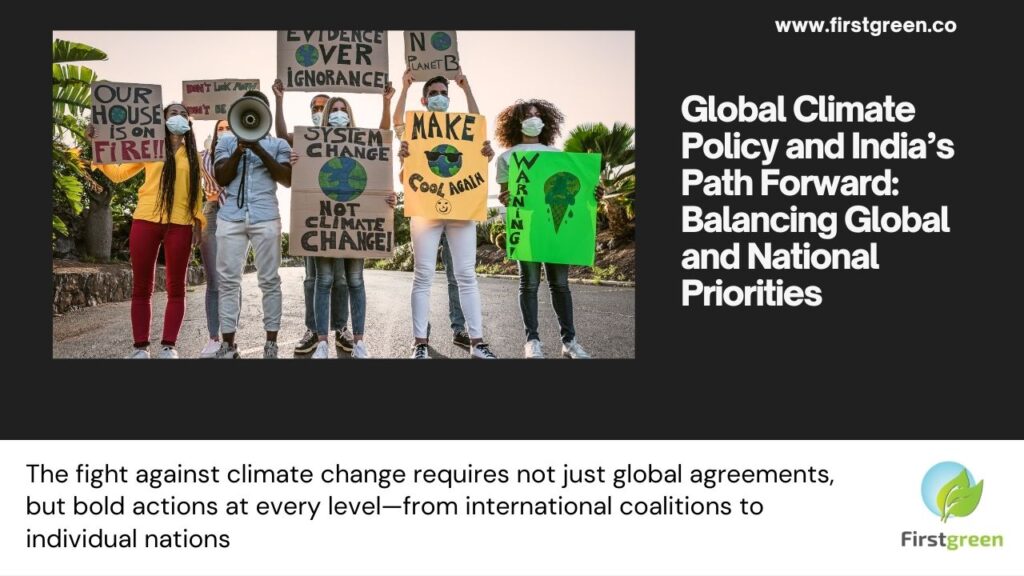Global Climate Policy and India’s Path Forward: Balancing Global and National Priorities

Introduction: As the world faces the escalating threat of climate change, coordinated efforts on greenhouse gas abatement have become crucial. National and sub-national initiatives, combined with international collaboration, are driving new approaches to global climate governance. The European Union (EU) has taken a leading role in these efforts, advocating for a unified global strategy with clear temperature targets to prevent dangerous levels of anthropogenic climate change. Meanwhile, India, as a significant player on the global stage, is advancing its own initiatives to align with international climate goals while addressing its unique developmental needs.
The EU’s Temperature Target: The EU has long committed to limiting global temperature increases to no more than 2°C above pre-industrial levels, based on strong scientific evidence. This goal is ambitious, especially considering that the Earth has already warmed by approximately 1.2°C as of 2023. The Intergovernmental Panel on Climate Change (IPCC) reports that global temperatures could reach or exceed 1.5°C within the next decade if current trends continue. Even if greenhouse gas (GHG) concentrations were stabilized at today’s levels, the Earth’s thermal inertia would likely push temperatures even higher, making the 2°C target increasingly difficult to achieve.
Challenges in Achieving the 2°C Target: Achieving the 2°C target is a formidable challenge. Policymakers must determine the appropriate levels of emissions and corresponding GHG concentrations to meet this target. However, the relationship between emissions, GHG concentrations, and temperature increases is complex. For example, the IPCC estimates that the risk of exceeding the 2°C target is 50% if GHG concentrations reach 450 ppm CO2 equivalent (CO2e). To stay below 1.5°C, concentrations would need to be limited to around 430 ppm CO2e, requiring a rapid reduction in global emissions.
India’s Climate Initiatives: While the EU sets ambitious climate goals, India is also making significant strides to combat climate change. As a developing nation with a rapidly growing economy, India faces the dual challenge of fostering economic growth while reducing emissions. In line with its commitments under the Paris Agreement, India has set an ambitious target to reduce its emissions intensity by 33-35% below 2005 levels by 2030. Additionally, India aims to achieve 50% of its installed electricity capacity from non-fossil fuel sources by 2030, a target that was updated at COP26 in 2021.
India is also aggressively expanding its renewable energy capacity, with a target of 500 GW by 2030. By the end of 2023, India had already installed over 170 GW of renewable energy capacity, making significant progress towards its goal. Initiatives such as the International Solar Alliance (ISA), co-founded by India, continue to play a crucial role in promoting solar energy across member countries, especially in the developing world.
The Role of the EU Emissions Trading System (ETS): The EU has implemented robust measures to meet its emission reduction goals, particularly through its Emissions Trading System (ETS). The ETS, now in its fourth phase (2021-2030), has been expanded to include new sectors such as maritime transport and to tighten the cap on emissions. The EU’s Fit for 55 package, which aims to reduce GHG emissions by at least 55% by 2030 compared to 1990 levels, further strengthens the ETS by reducing the number of available allowances and increasing the pace of annual reductions.
India’s Approach to Carbon Markets: India is also exploring carbon markets as a key tool for reducing emissions. The country’s Perform, Achieve, and Trade (PAT) scheme, targeting energy-intensive industries, operates as a market-based mechanism to incentivize energy efficiency improvements. India is now working on developing a national carbon market, announced in 2022, which aims to integrate existing mechanisms like the PAT and Renewable Energy Certificate (REC) markets. This national carbon market could eventually link with international markets, aligning India’s efforts with global climate goals.
Future Policy Directions: The EU is continuing to refine its approach to achieving its 2030 and 2050 climate targets. Beyond the ETS, the EU is focusing on increasing the share of renewable energy to 40% of total consumption by 2030, promoting energy efficiency, and advancing carbon capture and storage technologies. India, for its part, is pushing forward with its updated Nationally Determined Contributions (NDCs) under the Paris Agreement, which include increasing non-fossil energy capacity, enhancing forest cover to act as carbon sinks, and implementing the National Hydrogen Mission to develop green hydrogen as a future energy source.
Global Leadership and India’s Role: While the EU remains a global leader in climate action, India’s proactive measures, particularly in renewable energy development and carbon market exploration, position it as a critical player in the global climate arena. The challenges ahead are substantial, but India’s commitment to balancing economic growth with environmental sustainability highlights its potential to contribute significantly to global climate goals.
Conclusion: Addressing climate change requires coordinated international efforts and bold policy decisions. The EU’s leadership, particularly through the ETS and its Fit for 55 package, sets a strong example for other nations. Simultaneously, India’s initiatives reflect its unique developmental context and its commitment to global climate action. As both the EU and India continue to evolve their strategies, the global community must work together to achieve the temperature targets necessary to prevent catastrophic climate impacts. The path forward is challenging, but with global cooperation and national commitment, a sustainable future is within reach.